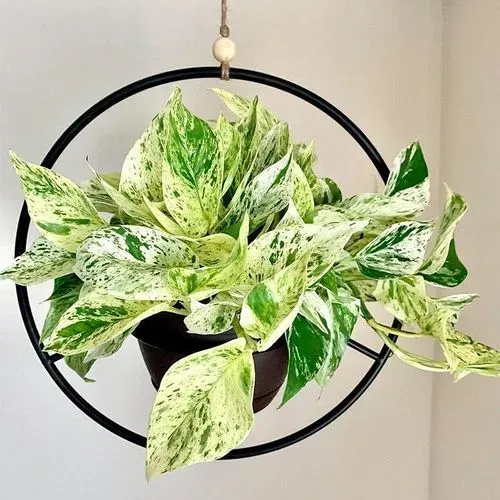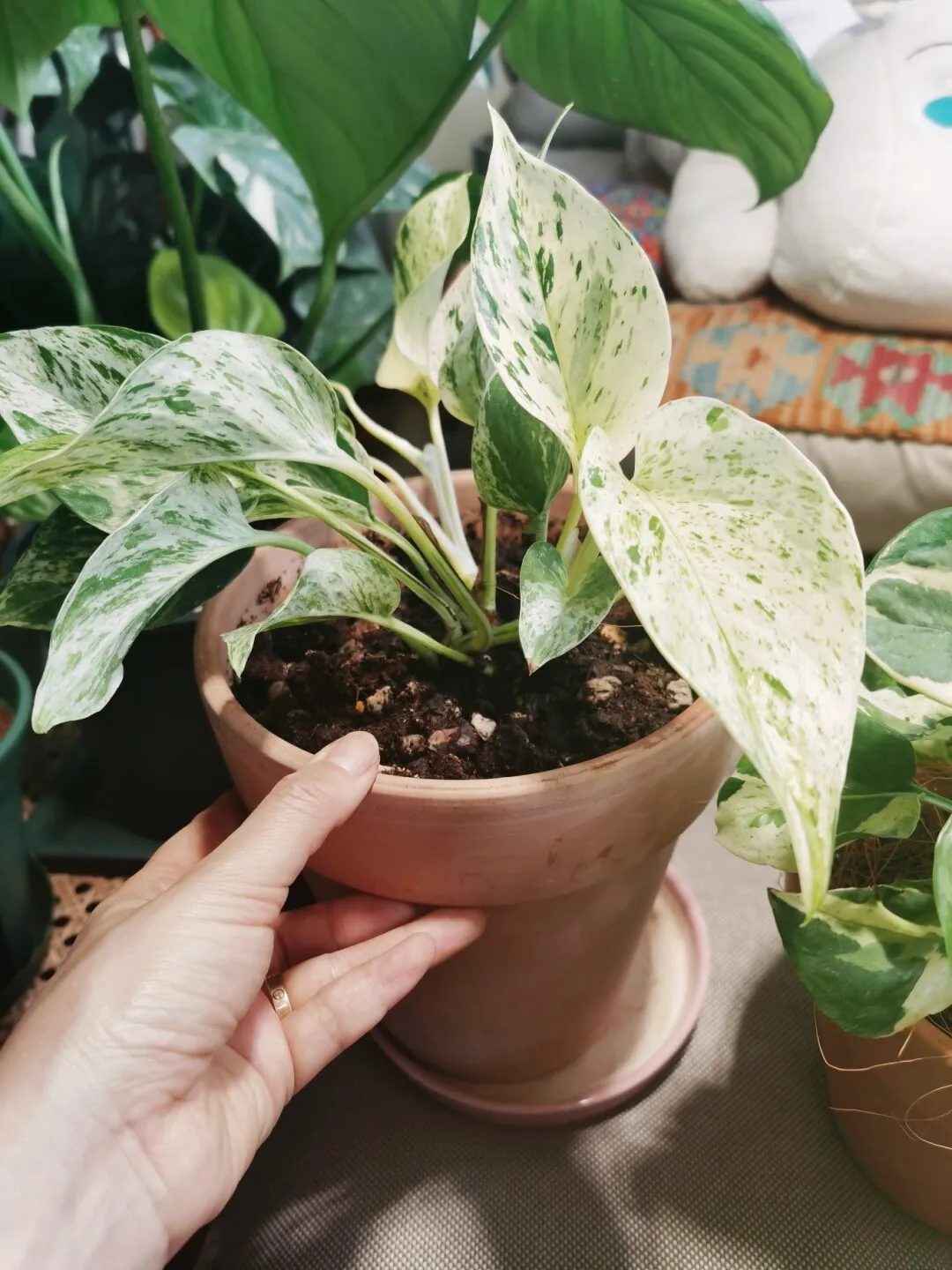Snow Queen Pothos VS Marble Queen Pothos - Difference & Similarity
Written by Ivy
Jan 20 2023

Snow Queen Pothos and Marble Queen Pothos belong to Epipremnum aureum varieties, but they also have differences and similarities. Snow Queen and Marble Queen Pothos can climb rattan and develop hanging basin green plants. We can put it anywhere in the office or home. You can hang it in the air to let its branches droop naturally and its stems and leaves grow downward, which is also very interesting.

Snow Queen Pothos

Marble Queen Pothos

Snow Queen Pothos
In the dark room, we should move the plant to the environment with strong light every half a month to recover for a period of time, otherwise it is easy to make the internodes grow and the leaves become smaller. (Read More: Why Are My Pothos Leaves Curling)
Marble Queen Pothos
Different water quantities are applied according to different seasons. In summer, when snow queen and marble queen Pothos have the greatest water demand, we can be more diligent and water every day to ensure the water demand of plants. Especially when it is dry, we can also spray some water to increase humidity. It's unusually cold outside in winter, but the temperature in the house will be high. We can give it every 4 ~ 5 days. The temperature in spring and autumn is relatively mild. Just water once in 3 ~ 4 days. The amount of one-time watering must not be too much, which is easy to burden the root. (Read More: How to Choose The Best Pot For a Pothos Plant)
Read more: How To Fix Overwatered Pothos .
.
Snow Queen Pothos
Of course, we can also choose to spray liquid inorganic fertilizer, about once every half a month. If we want to choose special fertilizer, we can't use ordinary fertilizer. Professional fertilizer absorbs relatively quickly, and ordinary fertilizer is not easy to be absorbed by snow queen and marble queen Pothos. Be careful not to spray too often. (Read More: Snow Queen Pothos Care & Propagation)
Marble Queen PothosThe newly trimmed Snow Queen Pothos and Marble Queen Pothos are very fragile. At this time, we need to put them in a place with ventilation and shade to dry the newly trimmed stem surface. If it is pruned in summer, it is recommended to supply water every day to meet the plant's water demand. If necessary, we can cooperate with water spraying. In the process of plant cutting and healing, it is not recommended to place the plant outdoors in the rain to prevent bacteria in the rain from infecting the plant, causing diseases and pests and unnecessary trouble.
Read More:
Differences Between Snow Queen And Marble Queen PothosLeaf ColorLeaf TextureLengthGrowth RateSimilarity Of Snow Queen And Marble Queen PothosTaxonomyGrowth HabitGrowing Requirements
Differences Between Snow Queen And Marble Queen Pothos

Snow Queen Pothos
Leaf Color
Snow Queen Pothos leaves have white patches, which are relatively large. There are many white spots on the leaves of marble queen Pothos, and even some leaves have green spots on a white background.Leaf Texture
Snow Queen Pothos is a variety native to India. Its leaves look like love as a whole. Of course, snow queen Pothos is more like manjula Pothos, but the irregular yellow stripes turn white. This snow queen Pothos also has a very special place, that is, the white spots on the leaves of snow queen Pothos will change according to the degree of illumination. Marble queen Pothos has beautiful leaves with green and white marble texture, which can be perfectly integrated with any decoration. Marble queen Pothos has many stripes, almost covering the whole leaf.
Marble Queen Pothos
Length
Snow Queen Pothos can grow up to 6-10 ft and Marble Queen Pothos can grow up to 5-6.5 ft.Growth Rate
Compared with snow queen Pothos, marble queen Pothos grows slowly. If you don't have much space, this slow growth has become a great choice.Similarity Of Snow Queen And Marble Queen Pothos

Snow Queen Pothos
Taxonomy
Both Snow Queen Pothos and Marble Queen Pothos belong to Araceae Family. And they have the same scientific name: Epipremnum aureum.Growth Habit
Snow Queen and marble queen Pothos like nutritious soil. When maintaining plants in winter, the growth temperature should not be lower than 15 degrees. When the weather is hot in summer, they need to spray more water on their leaves to meet their growth needs. However, marble queen Pothos needs proper sunshine and cannot be placed in a dark place for a long time.In the dark room, we should move the plant to the environment with strong light every half a month to recover for a period of time, otherwise it is easy to make the internodes grow and the leaves become smaller. (Read More: Why Are My Pothos Leaves Curling)
Growing Requirements
- Soil

Marble Queen Pothos
- Light
- Temperature
- Watering
Different water quantities are applied according to different seasons. In summer, when snow queen and marble queen Pothos have the greatest water demand, we can be more diligent and water every day to ensure the water demand of plants. Especially when it is dry, we can also spray some water to increase humidity. It's unusually cold outside in winter, but the temperature in the house will be high. We can give it every 4 ~ 5 days. The temperature in spring and autumn is relatively mild. Just water once in 3 ~ 4 days. The amount of one-time watering must not be too much, which is easy to burden the root. (Read More: How to Choose The Best Pot For a Pothos Plant)
Read more: How To Fix Overwatered Pothos
 .
.Snow Queen Pothos
- Fertilizer
Of course, we can also choose to spray liquid inorganic fertilizer, about once every half a month. If we want to choose special fertilizer, we can't use ordinary fertilizer. Professional fertilizer absorbs relatively quickly, and ordinary fertilizer is not easy to be absorbed by snow queen and marble queen Pothos. Be careful not to spray too often. (Read More: Snow Queen Pothos Care & Propagation)
- Prune

Marble Queen Pothos
Read More:
- Why Are My Pothos Leaves Turning Yellow
- Pothos Root Rot - Cause And Treatment
- How To Fix Overwatered Pothos
- Snow Queen Pothos VS Marble Queen Pothos
- How To Grow And Care For Manjula Pothos
- Hawaiian Pothos VS Golden Pothos
- Epipremnum Aureum (Golden Pothos) Grow and Care
- How to Grow and Care for Scindapsus Pictus
- Cebu Blue Pothos Care & Propagation
- Glacier Pothos Care & Propagation Guide
- Silver Satin Pothos Care & Propagation
- Pearls and Jade Pothos Care & Propagation
- Neon Pothos Plant Care Guide
Latest Updated
- Benefits of Bugleweed - 7 Science-backed Health Benefits
- Bugleweed Dangers & Side Effects - Is It Poisonous?
- How to Plant Evergreen Trees - What You Should Know
- When to Plant Evergreens - Grow Guide for Evergreen Trees
- 12 Wonderful Evergreen Shrubs for Your Garden
- 12 Popular Evergreen Plants with Pictures for Beginners
- When And How To Prune A Lilac Bush Like a Pro
- How to Grow & Care for Lilac Vine (Hardenbergia Violacea)
- Japanese Lilac Tree (Syringa Reticulata) Care & Propagation Guide
- Shumard Oak Pros and Cons - What to Know
Popular Articles
- Winter maintenance of Antirrhinum Majus
- How to Grow Terminalia Mantaly Tree
- How to Grow and Care for Crossostephium Chinense
- How to grow Antirrhinum Majus in spring
- Peristeria Elata (Dove Orchid) Profile: Info & Care Guide
- Underwatered Snake Plant (Sansevieria Trifasciata) - Signs And How To Fix
- How to Care for Brazilian Jasmine Plant (Mandevilla Sanderi)
- How to Grow & Care for Graptopetalum Purple Delight in Summer
- Rosa Chinensis (China Rose): Plant Growing & Care Tips
- How to Care for Baby Sun Rose (Aptenia Cordifolia)